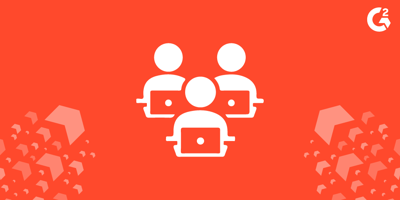August 4, 2025
.png?width=400&height=150&name=Untitled%20design%20(56).png) by Devyani Mehta / August 4, 2025
by Devyani Mehta / August 4, 2025

Most enterprise architectures are built on a fundamental misconception: that applications are the center of everything. Business logic, systems, and workflows revolve around them. Data is forced to conform, integrate, replicate, and migrate endlessly.
But what if that assumption is backwards?
It’s data — not applications — that belongs at the center of your architecture.
And reorienting around this truth unlocks a level of agility, scalability, and innovation that app-centric thinking simply can’t deliver.
This shift is already underway at leading enterprises. By embracing data-centric architecture, powered by modern data fabric software, organizations are replacing brittle app-bound systems with resilient, interoperable, AI-ready ecosystems.
A data-centric architecture is a method of structuring a system by putting data at the core of its design, functionality, and decision-making processes. The architecture prioritizes data as the most vital and valuable asset. Other system elements are then built around it to ensure smooth data management, processing, and retrieval.
In this article, you’ll learn why legacy application-first models are slowing your enterprise down and how a data-centric approach solves problems like data replication, siloed systems, and integration overhead while unlocking true digital agility.
Most enterprises today still rely on an application-centric model, where data is created, stored, and controlled within individual apps. This approach made sense when apps were simpler and integrations were rare. But today, the explosion of tools, users, and use cases has revealed just how inflexible and costly app-centric thinking really is.
In contrast, a data-centric architecture reimagines the enterprise stack by placing data — not applications — at the core. Instead of duplicating data across systems or forcing every new app to build its own database, a data-centric model creates a single, reusable source of truth that can power any number of applications.
Here’s how the two approaches compare:
| Attribute | App-centric architecture | Data-centric architecture |
| Primary focus | Applications and their internal data models | Enterprise data as a reusable, central asset |
| Data ownership | Tied to each application | Owned independently and shared via links |
| Integration efforts | High (custom ETL, APIs, replication) | Low (reuse via unified data fabric) |
| Data duplication | Frequent, often uncontrolled | Eliminated or minimized through linking |
| Agility and scalability | Low, due to brittle integrations | High, thanks to composable, adaptable data |
| Compliance readiness | Hard to trace or delete all data copies | Central control makes compliance more manageable |
| Application switching costs | High; data and logic are tightly coupled | Low; apps are replaceable, data stays intact |
| Collaboration potential | Siloed teams and fragmented insights | Cross-functional access and shared intelligence |
By shifting to a data-centric architecture, enterprises break free from legacy complexity and start treating data as a strategic asset, not a side effect of application use. This change unlocks the kind of operational flexibility modern businesses need to compete, scale, and evolve.
There’s a simple, although somewhat underwhelming, reason that modern enterprise architecture evolved to take an app-centric approach. It can be traced back to the first relational databases, which appeared in the 1970s, and the way they tied data to specific applications.
Big or small, every application has its own specific data model, and developers have had to build around that model. And that was never really a problem, until it became a major problem.
The proliferation of app-centric enterprise architecture has created a world where new solutions require custom access controls, lengthy integration projects, and extensive data replication. Every time you want to create a new solution or introduce a new capability, you’re forced to perform these ramp-up tasks of copying data and integrating systems.
As a result, enterprise architectures are brittle and fickle. One of the big rules for enterprise IT teams is to avoid changes to legacy systems at all costs, lest they break something critical. This is no way for today’s advanced businesses to operate.
And all this time, apps were really just a way to get to what really matters: the data. Your most complicated (and expensive) application would be nearly valueless without the names, numbers, and other data that it handles, right? Meanwhile, that same data would be just as important to your business regardless of what application you used to access it.
Your dependence on a specific application doesn’t come from the application itself, so much as the numerous solutions and integrations you’ve built on top of that application, each one making it that much harder to switch platforms. But if you could use that new data with a different application instantly, without needing integration efforts, it would have just as much value in your new system as it does now.
Data-centricity puts data at the heart of your architecture, where it belongs.
By putting data at the center of your enterprise architecture, you’ll unlock operational efficiencies that were impossible under the old, app-centric paradigm, and solve a number of problems that previously seemed unsolvable. Here are some of the key differences you’ll experience.
Data replication is one of the biggest problems for modern enterprise IT teams to manage, and yet every it is a fundamental necessity of an app-centric architecture. All of those integration efforts, which are required for virtually every new project, involve standing up new databases and copying over old data. As a result, your IT team spends a large portion of its time functioning as a very expensive data copying machine. This is not an efficient use of their time or their capabilities.
Furthermore, your data is only as secure as its most vulnerable copy, which makes rampant data replication a clear liability. Modern enterprises can have hundreds or even thousands of copies of data, and losing control over even a single copy can be disastrous.
But because of the established paradigm of app-centric thinking, enterprises have accepted widespread data replication as a necessity, and its many shortcomings as just part of the cost of doing business.
This is a bit like all the mental gymnastics that went into maintaining a geocentric view of the solar system despite all the observable evidence that things made much more sense if you accepted the sun as the center of things.
Data-centricity signals the end of data replication, because data is no longer tied to the particular application that creates it. Instead, it offers a single source of truth and uses links instead of copies to share data across multiple applications. This allows you to “reuse” data without making copies, and frees up your IT team so they can focus on building solutions instead of copying data.
When was the first time you heard about the importance of knocking down data silos? Ten years ago? Fifteen? Everyone knows data silos are bad, so why are they still everywhere?
It should be no surprise that data silos exist and persist because of app-centric design. As long as data is tied to the applications that create it, you’ll always need new databases when standing up new software. Because of this, “breaking down” data silos has really just meant “moving from smaller silos into bigger silos.”
While building a bigger silo provides a temporary solution, eventually you’ll find that you need to upsize again to “break down” the big silos you’ve been creating. The only way to actually stop building data silos is to move to a data-centric architecture.
Instead of setting up new databases and thus building bigger silos, data-centricity allows you to separate data from the application and move it into a network known as a data collaboration platform or data fabric. These platforms allow data to exist as a network, and this networked approach means that data can be shared and reused across various apps without making copies.
Because apps can reuse data in this network through links instead of copies, you’re never going to need a “bigger silo”. Any application you connect to your data collaboration platform will be able to make use of any data already on the platform. There’s simply no other way to create a permanent alternative to data silos.
No matter how good your IT department is or how advanced your technology may be, a business can only operate as fast as its tech stack allows. For app-centric businesses, any new project requires integration efforts and other groundwork before your existing data is ready to be applied to a new solution. This foundational work routinely eats up to 50% of an IT team’s time and budget for any given project.
The more complex the systems are, the more difficult they become to change. This is why legacy architecture is generally brittle and difficult, if not impossible, to change - change one piece and you threaten to break the whole thing.
Low-code and “no-code” technology may enable faster delivery from a front-end perspective, but they do nothing to eliminate the root cause of your problems or actually make your enterprise more agile. At best, they simply provide an illusion of improved efficiency. But until you address the complexity that limits your flexibility in the first place, you’re not creating meaningful change.
Data-centricity introduces plasticity to the enterprise schema, meaning the ability to change and adapt in real time. This is the meaningful change you need to permanently and immediately create enterprise agility, and the effects are remarkable.
By eliminating data copies and integration efforts, new solutions can be built in days instead of weeks. It suddenly becomes possible to operationalize new technology on timelines that were only fantasy under an app-centric approach.
For example, business agility is essential for fighting financial fraud through AI. The more advanced the fraud-detection algorithms become, the more devious and creative the criminals become in order to evade the algorithms.
When both sides are using app-centric approaches, it is difficult for either to gain a significant advantage. But when one side uses data-centricity to suddenly reduce the time it takes to implement change, it makes it next to impossible for the other side to keep up.
Building a data-centric stack? Add observability to the foundation. Explore the best data observability software to ensure your pipelines are trustworthy, traceable, and resilient.
Adopting a data-centric mindset isn’t enough; you have to operationalize it across your stack to unlock its full potential. That means building the infrastructure, processes, and culture needed to treat data as a shared, strategic asset, not an afterthought of application design.
This shift becomes especially powerful when it comes to two pressing enterprise priorities: AI integration and regulatory compliance.
In an app-centric model, data is fragmented across applications, making it difficult for AI systems to access consistent, high-quality inputs. That means more time wrangling data and less time generating insight.
Data-centricity changes the equation. With a unified, linkable data foundation:
This alignment turns AI from a siloed experiment into an embedded business capability and opens the door to more adaptive, intelligent systems across your organization.
Data-centricity also solves one of the hardest challenges in modern enterprise operations: compliance with evolving data privacy laws like GDPR, CCPA, and other global regulations.
Under GDPR, consumers have the right to understand how algorithmic decisions —such as loan approvals — are made. Under CCPA, they can demand that all personal data be deleted. In an app-centric world riddled with data copies, both requests can be nearly impossible to fulfill.
But with a data-centric architecture:
This isn’t just about risk reduction. It’s about regaining control over your data and being ready for whatever new regulations may come next.
No enterprise transformation is free of friction and data-centricity is no exception. While the benefits are massive, the path isn’t always smooth. Acknowledging the real-world challenges of adopting a data-centric architecture is essential to overcoming them and building the internal support you’ll need for success.
Here are four of the most common obstacles you’ll encounter on the journey, along with strategies to overcome them:
Many enterprises still rely on core systems that are decades old—and deeply entrenched in app-centric logic. These systems often resist change because they’re brittle, undocumented, or mission-critical.
You don’t need to rip and replace legacy systems to become data-centric. Start by wrapping them with a data access layer or data fabric that allows external apps to interact with the data without disturbing the legacy logic. This approach enables incremental change, reduces risk, and lets you gradually shift to data-centricity without shutting down operations.
Shifting from app ownership to shared data stewardship is more of a cultural change than a technical one. Teams may be hesitant to give up control or change familiar workflows.
Create a cross-functional data council to establish governance, communicate wins from pilot projects, and involve key stakeholders early. Position data-centricity not as a loss of control but as a way to enable innovation, reduce redundant work, and make teams more effective.
Traditional enterprise IT teams may lack experience with data modeling, semantic layers, or zero-copy access patterns.
Invest in training around modern data architecture concepts, bring in specialized partners for early projects, and build a center of excellence (CoE) for data practices. Starting with a smaller pilot team can help develop internal expertise without overwhelming your organization.
Moving toward a shared data model magnifies the consequences of bad data. If the data isn’t clean, well-defined, and trustworthy, reusing it across apps can multiply risk rather than reduce it.
Make data observability a first-class citizen in your architecture. Implement monitoring tools to track pipeline health, detect anomalies, and enforce data SLAs. High-trust data is the foundation of a functional data-centric system.
Making the leap to a data-centric architecture isn’t about avoiding challenges, it’s about choosing which problems you want to solve once and for all. While the path requires change, it leads to an environment where your data is finally free to support every app, team, and innovation you introduce.
Making the shift to data-centricity isn’t just a technology upgrade; it’s a mindset shift. Here are the essential steps to guide your enterprise through the transition:
A data fabric is a virtual layer that connects and manages data across systems without replication. It enables real-time access and sharing through links instead of copies, supporting data-centric models.
Fewer data copies mean fewer risk points. Centralized data control through a data fabric or similar platform makes it easier to audit, secure, and delete sensitive information when required.
Yes. You can “wrap” legacy systems with a data access layer or fabric, allowing them to participate in a shared data environment without needing to be replatformed or rewritten.
A big one. Since data is shared across multiple systems, monitoring quality, lineage, and performance becomes essential. Tools for data observability help maintain trust and prevent bad data from spreading. See the top-rated data observability tools on G2
Not exactly. Data-centricity is the philosophy of putting data first. A data mesh is one way to implement that philosophy — it treats data domains as products and decentralizes data ownership. Data-centricity can be achieved via data mesh, data fabric, or a hybrid of both.
Just like the sun has always been at the center of the solar system, data has always been at the center of your enterprise. It’s finally time to start treating it that way. Those who recognize this fact and are quick to embrace it will find themselves on the leading edge of a revolution, but they will find themselves there with company.
Some of the most complex organizations in the world, including highly-regulated financial institutions, have already started the transition to data-centricity.
These businesses are accelerating their solution delivery, de-risking their data security, and unlocking real business agility. And every day, they’re increasing the advantages they have over companies who remain centered on applications.
If you’re still adhering to the 40-year-old app-centric approach, it will be next to impossible to compete with modern, data-centric businesses as their numbers continue to grow. After all, successful businesses already operate as efficiently as possible, and squeezing meaningful change out of your architecture is extremely difficult.
Instead of eking out fractions of a percent in improvement, it’s time to embrace a paradigm change like data-centricity. When you can eliminate integration efforts and instantly free up 50% of your IT resources on any project, you will have the bandwidth you need to deliver enterprise-changing innovation.
You can't build a data-centric architecture with corrupt data. Monitor and secure your business data with the best data-centric security software.
This article was originally published in 2023. It has been updated with new information.
Devyani Mehta is a content marketing specialist at G2. She has worked with several SaaS startups in India, which has helped her gain diverse industry experience. At G2, she shares her insights on complex cybersecurity concepts like web application firewalls, RASP, and SSPM. Outside work, she enjoys traveling, cafe hopping, and volunteering in the education sector. Connect with her on LinkedIn.
Modern technology allows companies to collect and harness more useful data than ever. They...
 by Pohan Lin
by Pohan Lin
How do companies tackle challenges that span across various regions and countries?
.png) by Devyani Mehta
by Devyani Mehta
It doesn’t matter how many metrics you’re tracking, goals you’ve set or board members you have...
 by Amy Lecza
by Amy Lecza
Modern technology allows companies to collect and harness more useful data than ever. They...
 by Pohan Lin
by Pohan Lin
How do companies tackle challenges that span across various regions and countries?
.png) by Devyani Mehta
by Devyani Mehta


